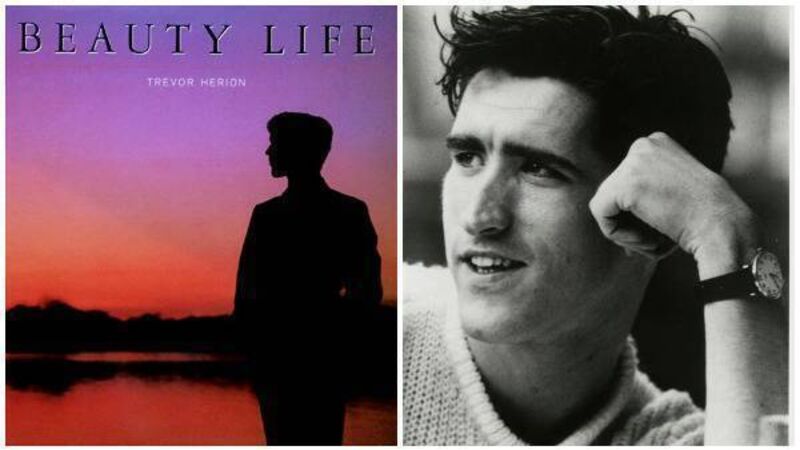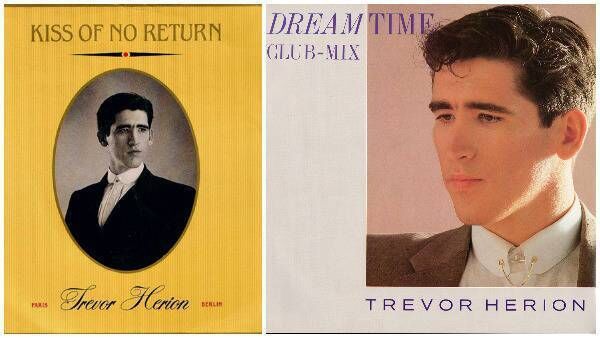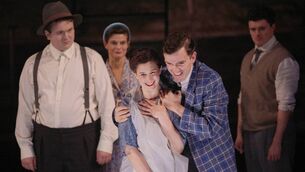B-Side the Leeside: Trevor Herion - Beauty Life

Trevor Herion, and the cover of Beauty Life.
UK musician/producer Thomas Dolby laughs as he recalls the time Cork-born Trevor Herion ran out of a London studio in the middle of a recording session.
“He came back about three-quarters of an hour later,” Dolby remembers. “I said, ‘What happened Trevor, where’d you go?’ and Trevor said that he had to go home because he realised that he’d left some tripe on the stove.” Dolby asks me what tripe is, “Cow’s or sheep’s intestines or something?”
I describe the traditional Irish culinary offal to him. “Well by the time he got home the saucepan had exploded,” continues Dolby. “The tripe was all over his ceiling.” You can take the boy out of Cork…
In 1981 as Dolby was recording his debut album he also played keyboards and produced two singles for Herion’s band The Fallout Club. The synthpop band also featured punk drummer Paul Simon, and Matthew Seligman on bass guitar. Those singles, ‘Wonderlust’ and ‘Dream Soldiers’, are obscure gems. Classic Pop magazine wrote that ‘Dream Soldiers’, “emits an almost hallucinatory aura, both intensely moving and a sight unsettling.”
Prior to The Fallout Club, Herion and Simon played in The Civilians. Hans Zimmer – long before composing Hollywood soundtracks – guested on synthesiser for The Civilians at a few recording sessions.
Cork-born Richard Haughton, the celebrated music and fashion photographer, met Zimmer, Dolby and Trevor around this time. “All of them were in similar stages of their careers, doing their first records, finding where they were,” recalls Haughton. “None of them were what you would call New Romantics, but they were all sort of hovering around romantic ideas of self-presentation of art.”
After The Fallout Club’s demise, Herion went solo and Dolby arranged his debut single ‘Kiss of No Return’. Smash Hits wrote, “absolutely gorgeous, Trevor croons away, mentions Paris and wins my heart.” The pair remained close with Trevor appearing in the video for Dolby’s ‘She Blinded Me With Science’.
Herion’s album Beauty Life followed in 1983, produced by Culture Club producer Steve Levine. Beauty Life is a striking mix of funky Chic-like rhythms, electro pop, blue-eyed soul and smoother jazz-tinged sounds with Trevor’s big voice on top, a perfect archetype of the ‘lost classic’.
Herion was born in Cork, where his family lived in Mount Farran, Assumption Road. “Herion might seem like an unusual surname but it’s quite common in South Africa,” says Marian, Trevor’s older sister. “My father was from South Africa and he worked on boats. He was in Cobh and he came into Cork for a dance and that’s where he met my mum, Bridget Sullivan from Blackpool.”
The newly married couple moved to South Africa where they had two children, Marian and her brother Brian. The family returned to Cork and Trevor was born soon afterwards followed a few years later by a fourth sibling, Madeline.
In the late 1960s the family left Cork. “My father was working on the French ferries in and out from Southampton,” remembers Marian. “I was about twelve when we moved to England and Trevor was about eight.”
Trevor’s love of music, particularly his love of opera, came from his mother. “My mother was a great singer, a great lover of opera, she had a great range,” recalls Marian. “She was a brilliant dancer, she actually appeared a few times at the Cork Opera House, she won a talent contest there when she was in her teens.”
Trevor’s records are distinguishable from others of the period by his rich distinctive voice. Dolby remembers that singing was everything to Trevor. “You could see the anguish and ecstasy on his face when he was singing, it almost seemed like he was channelling some ancient Italian tenor, a Caruso or someone,” says Dolby.
“He was haunted by the ghost of former torch singers. In Joyce’s Dubliners there’s a lot of mentions of house parties where the latest Italian tenor would be in town. I always got the sense that Trevor’s love of opera sort of related to that in some way – that Italian-Irish connection.”

After ‘Kiss of No Return’ Trevor began recording with producer Steve Levine. Both were signed to Rondor Music and Levine remembers meeting Trevor at the publishing company’s offices. “I kept seeing him in the reception and this is the time when I was working with Culture Club.” “We were just chatting, ‘What are you doing?’ It was that kind of conversation. He was a writer and he said, ‘You know what? I’d really love to work with you on something’. He played me some of his stuff. I thought it was really unusual and really weird, but in an interesting way, so I said yes.”
Levine assembled an incredible band of session musicians and backing vocalists to record Beauty Life. “He was an avant-garde independent artist who had a fascination with funky rhythmical music,” the producer remembers. “He was almost like an Irish David Byrne or an Irish Billy Mackenzie [the Associates] than anything else, I think that he’s sort of somewhere between the two.”
The sleeve of Beauty Life and its singles were designed by famed Factory Records designer Peter Saville with photography by Haughton.
“He was a good-looking man in a very old-fashioned Irish way,” recalls Haughton. “The photograph on the cover of his single ‘Dreamtime’ is very Trevor, very period. It’s not at all John McCormack but again that was probably another of Trevor’s influences. There’s a hint of Gabriel Byrne I suppose as well, but a very different aesthetic.”
That aesthetic was based on Trevor’s desire for a unique look. “He wanted to stand out. I remember him not having much money but he went to a tailor in Saville Row and he had this pale cream linen suit made to measure with gold stripe going through it,” remembers Marian. “Nobody would wear that sort of thing in those days. He’d wear a black cloak, silk-lined in red and a cane with a silver top - very Oscar Wilde.”
Haughton agrees that Trevor’s look was striking: “It was classic Edwardian without any contemporary twist at all, quite Irish Edwardian, it was quite a specific take on that look.”
At the heart of Trevor’s music is the palpable longing in his voice. “He seems to be reaching out for something intangible that he can’t get a hold of,” says Dolby. “There’s maybe a loneliness behind it that you can sense, that somebody is trying to climb out of their loneliness and isolation.”
It’s an opinion that Marian agrees with: “I think Trevor was a bit like Pagliacci [the sad clown], he was always making other people laugh but I think he had a real sadness within him.”
Marian links this sense of sadness to Trevor’s sexuality: “I think his identity was in crisis, I think he was gay and I think it was a big struggle for him because first of all it wasn’t spoken about, and even then if one was gay it was often regarded as a shameful thing.”
Tragedy struck the family in 1986 when Trevor’s younger sister Madeline took her own life. Trevor’s deep-seated sense of sadness became more pronounced. “When Madeline died Trevor went totally off his head, sometimes he wouldn’t sleep for days and that affected him as well,” explains Marian. “That’s when he was really depressed. I think all of it had some sort of bearing on a troubled mind. Back then we didn’t speak about depression the way we do now.”
In 1988, less than two years after his sister’s death, Trevor took his own life. He was 28 years of age. When she thinks of Trevor, Marian says she is overwhelmed by feelings of sadness and pride.
“I miss him dreadfully because he was such a character, he was very good to everybody, he had a fabulous imagination and a great sense of humour. He had a very big heart and I think he sang from his heart,” she says. “I’m sure a lot of people might find Trevor’s story interesting and if a few more people listen to his music I think it will have been worth telling. I really think he had a talent. I don’t think there’s anyone else that sounds like him, before or after.”







